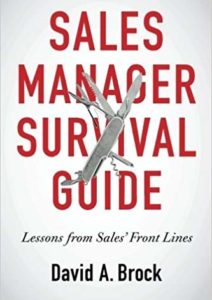By now, you know my obsession with strong Selling Processes. It’s important, but misunderstood aspect of sales effectiveness. One of the things I’ve discovered as a result of my diatribes, is many sales managers really don’t know how to reinforce the sales process in their coaching and development of their sales teams. I’ve gotten a lot of questions on this topic from sales managers, and I suspect there are a lot more that are embarrassed to ask about this. Often, I when I get involved in review meetings, I find myself in a role of coaching both the salesperson and in showing executives how they should be conducting the reviews and coaching their people.
I thought it worthwhile to address the issue, primarily focusing on sales managers, helping them to better understand how to use the sales process more effectively in conducting reviews and in coaching their people. If you are an individual contributor–don’t despair, you can learn a lot as well.
First some level setting, there are many processes and activities in the sales function. When I talk about the “selling process,” I’m focusing on the set of activities and outcomes required to move a qualified prospect through their buying process to a decision. The selling process is the set of activities we execute, aligned with the customer buying process. Stated differently, the selling process is all about the deal or the opportunity and how to manage working with the customer most effectively.
There are two sets of activities, critical to sales managers, in which the selling process is the core, first it is the deal/opportunity strategy–and the process for reviewing opportunities. Second, it is the health of the pipeline/funnel–and the process we use for reviewing pipelines or creating a forecast. In this blog post, I will focus on the deal review.
As a manager doing deal reviews with sales people and sales teams, generally there are several objectives:
-
A business management objective. As a manager, I want to understanding the status, strategy, and what we are doing about a specific deal, so that I can make sure the sales team is executing the strategy that will most likely produce a win.
-
A coaching objective oriented toward improving the salesperson’s abilities to develop and execute winning strategies. We leverage coaching on a specific deal, with the objective they apply the lessons to all other deals.
-
A combined business management/coaching objective. Using a specific opportunity to give me a sense about how well they are managing the other opportunities they are working on. Pragmatically, I can’t review every deal they are working on (nor to they want me micromanaging them). If they are managing the process well in the few deals I inspect, then I can have reasonable confidence they are managing the other deals well. Effective managers manage the process, not transactions.
I think it’s important that managers conduct at least one deal/opportunity review with each salesperson every week. Properly structured, it should take 20-30 minutes (unless it’s a huge/complex deal).
Too often, managers choose the wrong deals to review, focusing on deals that are about to close. This is probably the type of opportunity to do a review on–if it’s about ready to close, there’s not much that can be done to adjust the strategy and improve the ability to win. Our greatest leverage on deal reviews is opportunities that have just been qualified and are in the discovery or early proposing stages. Over time, with each salesperson, the manager should conduct review on deals in all stages of the pipeline.
Another mistake managers make in doing deal reviews is lack of preparation. Consequently, much of the time is spent reviewing past history rather than focusing on the things we should do to strengthen our strategy and compress the sales cycle. So before starting the review, spend a few moments studying the deal in the CRM system. The first pieces of data I want to look at are where they are in the sales process. I want to look very specifically at where they are–what phase are they in (i.e. qualifying, discovery, proposing, closing) and what activities they have completed–yes, I do look at the check boxes. I look at what’s changed since the last time I reviewed the deal to get a general sense of the progress that has been made. I may skim notes–but probably not. If we have a good process in place and the deal has been updated, it only takes me a couple of minutes to get a good sense of things and to start to prepare the questions I want to ask. Some things I scan in preparing:
-
Is there alignment between where we are in the sales process and the target close date? For example, if we are in the discovery phase of a complex deal, and it is forecast to close within 2 weeks, I wonder,” How are we going to complete all that needs to be done to move it from discovery to closure in 2 weeks?
-
What activities have been skipped (are not checked)? We identify activities in the sales process because we know them to be critical to our success, why are we skipping these activities? There may be legitimate reasons, but I will want to understand this.
-
Do the next steps and action plans make sense with where we are in the process, our positioning, and the competition?
By now, you are probably wondering, what if the salesperson hasn’t updated the CRM or reporting systems. If they haven’t taken the time to do this, then they are wasting everyone’s time. It’s their obligation to have the most updated information in the systems.
This preview minimizes the amount of time the salesperson has to spend reviewing history. We can focus our time on where we are and what we do next.
In the review, I do the following:
1. I dive into 2-3 key critical activities that have been completed, asking the salesperson to give me a deeper understanding and better context. For example, if the salesperson has checked the activity, “We understand who is involved in the decision-making process and how the decision will be made,” I will turn this activity into a question, “Who’s involved in the decision and how will they make a decision?” (Duuuhhh—use the sales process as you crib sheet for the deal review). If the salesperson cannot describe it well, if they start waving their arms around too much or fumbling, red flags start going up in my mind. I worry, do they have an accurate assessment of where they are in the sales process, are they managing it as effectively as possible? I’ll drill down on this question a little.
If they give a well-thought-out response, I’ll inspect a couple of other completed items in a similar manner. This discussion gives me a view of how completely they’ve executed the process to date, how well they understand and are managing the deal, and how effectively they are executing. If the responses are good, we’ll move forward.
If the answers are poor, we’re probably in trouble with this deal. We probably have to reset the whole deal strategy with the salesperson, hopefully, being able to recover and move forward successfully with the customer.
2. If the salesperson is managing the deal effectively, we focus the discussion on “What’s next?” This is where managers can add real value in coaching the salesperson and improving the deal strategy. The next steps in the sale process give us our starting point. What’s happened, the customer attitudes/perceptions, our competitive positioning provide greater richness to the discussion. The discussion might include a SWOT analysis with the salesperson, identifying opportunities, threats and the actions required to address them. We can challenge the salesperson on our value creation, getting them to make sure the value they are creating is relevant and differentiated. We can challenge the salesperson to think about compressing the sales/buying cycle.
It’s important for the manager to challenge the salesperson about the strategy, getting them to think about the most appropriate things to do next. Effective coaching has the person discovering these themselves. When we get into “tell mode,” we actually transfer ownership of the strategy from the salesperson to ourselves. Done right, the review becomes a collaborative problem solving session–with an outcome probably better than either person could have created alone.
3. At the conclusion of the review, the salesperson should have identified all the next steps. What needs to be done, who is responsible, and when they need to be completed. The salesperson should update the CRM system with these next steps, to make sure they are accomplished.
Following the review, it’s important for managers to follow up on key activities, making sure they are executed, check pointing to see if they had the desired impact or if we need to adjust the strategy going forward. (A little trick I use to remember to follow up is immediately after the review session, I take a few minutes to write my follow up emails in Outlook–scheduling them for future delivery. That way, I don’t have to remember–and when the follow up occurs, I get copied and can discuss things with the salesperson.)
It’s amazing how much we can accomplish in a short period of time if we have a structure to the way we conduct deal reviews.
Photo credit (featured image): legendarynd.wordpress.com












